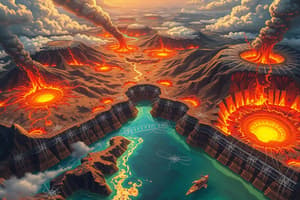Podcast
Questions and Answers
What type of boundary is characterized by the collision of two plates?
What type of boundary is characterized by the collision of two plates?
- Converging Plate Boundaries (correct)
- Transform Boundaries
- Static Boundaries
- Diverging Plate Boundaries
Which type of converging plate boundary involves the subduction of an oceanic plate under another oceanic plate?
Which type of converging plate boundary involves the subduction of an oceanic plate under another oceanic plate?
- Oceanic-Continental
- Transform
- Oceanic-Oceanic (correct)
- Continental-Continental
What geological feature is formed at Oceanic-Continental converging plate boundaries?
What geological feature is formed at Oceanic-Continental converging plate boundaries?
- Volcanic Islands
- Mountain Ranges (correct)
- Deep Sea Trenches
- Ocean Basins
What is the primary result of Transform Boundaries in geological terms?
What is the primary result of Transform Boundaries in geological terms?
Where can seafloor spreading predominantly occur?
Where can seafloor spreading predominantly occur?
Which feature is associated with Oceanic-Oceanic converging plate boundaries?
Which feature is associated with Oceanic-Oceanic converging plate boundaries?
Which type of plate boundary produces the highest mountain ranges?
Which type of plate boundary produces the highest mountain ranges?
What phenomenon is commonly associated with converging plate boundaries?
What phenomenon is commonly associated with converging plate boundaries?
What force is primarily responsible for the movement of tectonic plates?
What force is primarily responsible for the movement of tectonic plates?
What happens to a plate when it is subducted during a collision?
What happens to a plate when it is subducted during a collision?
Seafloor spreading occurs at which type of plate boundary?
Seafloor spreading occurs at which type of plate boundary?
What is formed as magma rises to fill the gap between diverging tectonic plates?
What is formed as magma rises to fill the gap between diverging tectonic plates?
Which scientist is credited with proposing the theory of seafloor spreading?
Which scientist is credited with proposing the theory of seafloor spreading?
What geological feature is commonly formed at ocean trenches?
What geological feature is commonly formed at ocean trenches?
What happens to the seafloor as new ocean crust is formed at divergent boundaries?
What happens to the seafloor as new ocean crust is formed at divergent boundaries?
What is the effect of mantle convection on tectonic plates?
What is the effect of mantle convection on tectonic plates?
Flashcards
Seafloor Spreading
Seafloor Spreading
The theory that explains how new ocean crust is formed at mid-ocean ridges and destroyed at deep-sea trenches.
Tectonic Plates
Tectonic Plates
Enormous slabs of Earth's crust and rigid upper mantle that move on the planet's surface.
Plate Tectonics
Plate Tectonics
The movement of tectonic plates driven by the convection currents in the Earth's mantle.
Convection Currents
Convection Currents
Signup and view all the flashcards
Plate Boundaries
Plate Boundaries
Signup and view all the flashcards
Diverging Plate Boundaries
Diverging Plate Boundaries
Signup and view all the flashcards
Subduction
Subduction
Signup and view all the flashcards
Ocean Trench
Ocean Trench
Signup and view all the flashcards
Converging Plate Boundaries
Converging Plate Boundaries
Signup and view all the flashcards
Oceanic-Oceanic Converging Boundary
Oceanic-Oceanic Converging Boundary
Signup and view all the flashcards
Oceanic-Continental Converging Boundary
Oceanic-Continental Converging Boundary
Signup and view all the flashcards
Continental-Continental Converging Boundary
Continental-Continental Converging Boundary
Signup and view all the flashcards
Transform Boundaries
Transform Boundaries
Signup and view all the flashcards
San Andreas Fault
San Andreas Fault
Signup and view all the flashcards
Mid-Atlantic Ridge
Mid-Atlantic Ridge
Signup and view all the flashcards
Study Notes
Types of Plate Boundaries
- Seafloor spreading is a theory proposing that new ocean crust forms at mid-ocean ridges and is destroyed at trenches.
- Plates are large slabs of Earth's crust and upper mantle.
- Convection currents in the mantle drive plate movement.
- Magma rises at mid-ocean ridges, creating new seafloor.
- Plates collide at convergent boundaries, where one plate may subduct (slide under).
- Subduction results in volcanic activity and deep trenches.
- Divergent boundaries are where plates pull apart, forming rift valleys or mid-ocean ridges.
- Transform boundaries are where plates slide past each other, generating earthquakes.
Divergent Boundaries
- Plates move apart, creating gaps.
- Magma rises to fill the gap, forming new seafloor.
- Mid-ocean ridges are examples of divergent boundaries.
- Found primarily under the oceans, creating new seafloor.
- Earthquakes and volcanic activity frequently accompany divergent boundaries.
- Iceland is a unique location with a divergent boundary on land.
Convergent Boundaries
- Plates collide.
- One plate may subduct (slide under) another, leading to trenches.
- Subduction causes volcanic activity.
- Oceanic-oceanic collisions form volcanic island arcs.
- Oceanic-continental collisions result in volcanic mountain ranges.
- Continental-continental collisions create the highest mountain ranges.
Transform Boundaries
- Plates slide past one another horizontally.
- This movement generates tremendous stress and strain.
- Earthquakes are a common feature of transform boundaries.
- The San Andreas Fault is an example of a transform boundary.
Practice Questions
- The San Andreas Fault is a transform boundary.
- Mid-Atlantic Ridge is a divergent boundary.
- Andes Mountains are associated with an oceanic-continental convergent boundary.
- Mariana Trench is an oceanic-oceanic convergent boundary.
- Aleutian Islands are related to an oceanic-oceanic convergent boundary.
Studying That Suits You
Use AI to generate personalized quizzes and flashcards to suit your learning preferences.




